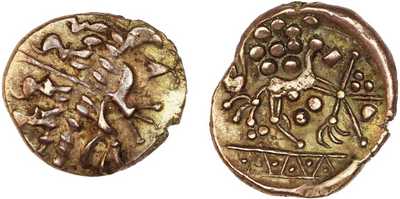Yarmouth
Notes | Most coins in the range 6.07g to 6.32g. One (CCI-610385) is 4.11g and possibly plated. There are 16 class 1 coins recorded, 9 of which are in museums, and one class 2 coin which is in a private collection. The three-pronged item on the obverse can be seen on the reverse of ABC 767 (Hampshire Thunderbolt) and British Da2 (Curdridge Triad). The bell shaped object on the obverse can be seen on a range of quarter staters, such as the Hampshire Thunderbolt (ABC 767), British Da2 (Curdridge Triad), Sills Insular Cf (ABC 530), Phallic Geometric (ABC 533), British Aa2, Westerham Geometric (ABC 2451), and Westerham Reversed L (ABC 2454). This coin lends weight to the theory that some Celtic coin designs were derived from trance imagery. This is a composite of three seperate coins which are Copyright © Trustees of the British Museum (CC BY-NC-SA 4.0) |
Tribe | Regini |
Denomination | Stater |
Metal | Gold |
Obverse Legend | No Legend |
Obverse Description | Typical Celtic degraded head of Apollo, but with a missing face. Instead, the hairbar ends with a three pronged object in the nose area, below which a crescent has three claw like crescents hanging from it. Above the three pronged "nose", to the right, is a bell shaped object |
Reverse Legend | No Legend |
Reverse Description | Class 1: Yarmouth Right Right facing horse with a tail ending with three crescents, each one ending in a pellet. The forelegs are formed by a six bladed windmill motif with a pellet centre. Two arms are parallel, forming the horse's forelegs. The lower arm of the windmill (the horse's foot) is a three toed claw. The segment between the upper right arms has a pellet triad, and the one below has an undeterministic object. There are nine bold pellets above and three below the horse. Above the horses tail is an object that's possibly a lyre (best seen on CCI-680834 and CR 160 lot 9.jpg). The exergue is formed of two parallel lines, joined by alternating diagonal lines. Between the diagonal lines are single pellets. Class 2: Yarmouth Left Similar to class 1 except that the horse faces left, the tail changes to a four-armed spiral, and the three toed claw on the "windmill" is now a seperate element. Only one example is known |
Area | Britain |
Region | Southern |
Weight | 4.11g to 6.65g |
Date | 55 BC to 45 BC |
References |
Catalogue
| Photo | Notes |
|---|---|
6.65g. Right Type
| |
Photo Copyright Oxford University & The Portable Antiquities Scheme (CC BY-SA 4.0) 6.32g. BMC 80
| |
Photo Copyright Oxford University & The Portable Antiquities Scheme (CC BY-SA 4.0) 6.24g. BMC 81
| |
Permission to use the photograph was denied, but you can see it if you click here. 6.22g
| |
Photo Copyright Oxford University & The Portable Antiquities Scheme (CC BY-SA 4.0) 6.21g. BMC 85
| |
Photo Copyright Oxford University & The Portable Antiquities Scheme (CC BY-SA 4.0) 6.21g. BMC 83
| |
Photo Copyright Oxford University & The Portable Antiquities Scheme (CC BY-SA 4.0) 6.19g
| |
Photo Copyright Oxford University & The Portable Antiquities Scheme (CC BY-SA 4.0) 6.19g
| |
Photo Copyright Oxford University & The Portable Antiquities Scheme (CC BY-SA 4.0) 6.15g. BMC 84
| |
Photo Copyright Oxford University & The Portable Antiquities Scheme (CC BY-SA 4.0) 6.14g
| |
Photo Copyright Oxford University & The Portable Antiquities Scheme (CC BY-SA 4.0) 6.14g. BMC 78
| |
Photo Copyright Oxford University & The Portable Antiquities Scheme (CC BY-SA 4.0) 6.12g. BMC 82
| |
6.1g
| |
Photo Copyright Oxford University & The Portable Antiquities Scheme (CC BY-SA 4.0) 6.07g. BMC 79
| |
Photo Copyright Oxford University & The Portable Antiquities Scheme (CC BY-SA 4.0) Unknown Weight
| |
Photo Copyright Oxford University & The Portable Antiquities Scheme (CC BY-SA 4.0) 4.11g. Low weight - possibly plated.
|















